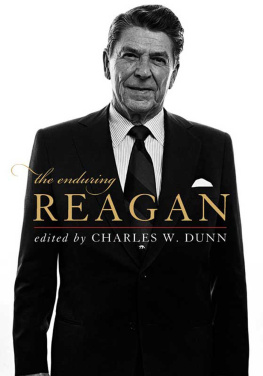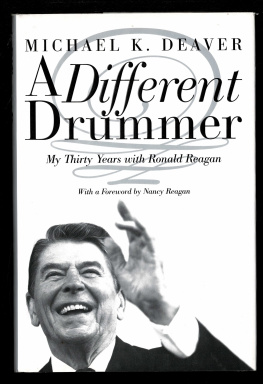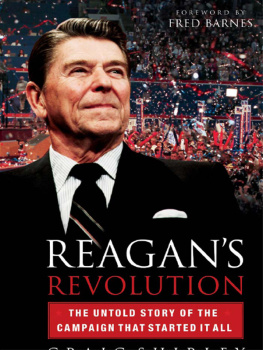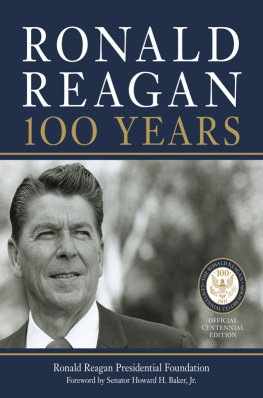Table of Contents
PRAISE FOR LOU CANNONS
Governor Reagan
A lucid account... For all its familiarity Governor Reagan is a welcome achievement, correcting not just this important politicians knee-jerk critics but also his beatifiers.
The New York Times Book Review
Cannon, who began covering Reagan before he became Californias governor in 1966, manages to unwrap the riddle-cum-enigma as well as anybody ever has.... [T]his book, Cannons fifth on his riddle, is also his most serious and searching, not just about Reagan but also about a watershed era in California and national politics.
The Los Angeles Times Book Review
The campaign scenes in Cannons smart, savvy book play like the original production of a farce whose modern-dress revival weve all, willingly or not, just sat through... its amazing how much fresh detail he breathes into a story that many Californians probably think they know by heart... What lifts Cannons work on Reagan leagues above Edmund Morris semi-authorized Dutch is Cannons authoritative grasp of the materialthe likelihood that, when he narrates what went on in a meeting, hes talked about it more than once to almost all the people in the room.
The San Francisco Chronicle
As a person and as a political figure, Ronald Reagan was far more complex than most of his fellow citizens understood. But Lou Cannon, a brilliant reporter who has known and covered Reagan for nearly forty years, understood. He has been Reagans best biographer. And now, drawing upon a wealth of new material, Cannon illuminates Reagans Sacramento yearshis apprenticeship for the presidency.
George F. Will
[F]or anyone wishing to understand the Reagan phenomenon, Governor Reagan is factual, objective, and ultimately, indispensable.
The Baltimore Sun
Cannon is considered by many to be the leading contemporary Reagan biographer. Here he does a stellar job of recounting Reagans first two terms in higher office as governor of California. Cannon recounts all this... with skill and grace, painting a vivid portrait of a formidable politician in the process of becoming.
Publishers Weekly starred review
The Reagan books proliferate, written by friends, enemies, idolaters, ax-grinders. But those of Lou Cannon remain the best. That is undoubtedly due to the fact that Cannon began as, and remains, a bluff, skeptical, meat-and-potatoes, shoe-leather reporter.... Cannons virtues include an absence of ideology and a willingness to dig for facts and keep at it.
The Norfolk Virginian-Pilot
ALSO BY LOU CANNON
Ronnie and Jesse: A Political Odyssey (1969)
The McCloskey Challenge (1972)
Reporting: An Inside View (1977)
Reagan (1982)
Official Negligence: How Rodney King and the Riots
Changed Los Angeles and the LAPD (1998)
President Reagan: The Role of a Lifetime (1991, 2000)
Ronald Reagan: The Presidential Portfolio (2001)
To Mary, with love and appreciation,
and for Carl, David, Judy, and Jack,
and Nicholas, Kelly, Grace, Tiffany, Stephanie, and Nathan,
and with special thanks to Bill Clark, Ike Livermore,
Tom Reed, Stuart Spencer, and George Steffes
ACKNOWLEDGMENTS
THE IDEA FOR A COMPREHENSIVE examination of Ronald Reagans governorship of California was conceived in a series of conversations with my publisher Peter Osnos, my editor Robert Kimzey, my agent Kristine Dahl, and my wife and researcher, Mary Cannon. Our premise was that the governorship and its influence on Reagans presidency had been unduly neglected. Although I wrote extensively about the early governorship in my first book, Ronnie and Jesse: A Political Odyssey, published in 1969, it covered only two and a half years of Reagans eight-year governorship. While I examined later aspects of his governorship in a 1982 book, Reagan, this biography focused on Reagans pursuit of the presidency. So we conceived of a new book that would stand on the shoulders of my earlier works but make use of material that has become available since they were written.
Fortunately, Governor Reagans first cabinet secretary, William P. Clark, made available to me the complete minutes of the cabinet meetings of the early governorship taken at his direction by his secretary, the meticulous Helene von Damm. I had utilized a few of these revealing minutes in Ronnie and Jesse; Clark supplied all of them for this book. Clark, who subsequently served as Reagans chief of staff in Sacramento, also provided a key interview and helped on many details. Later cabinet minutes, which are stored at the Ronald Reagan Presidential Library in Simi Valley, California, were made available by the Ronald Reagan Presidential Foundation through the courtesy of Nancy Reagan and Joanne Drake. I have examined all of these minutes.
Thomas C. Reed, Reagans first appointments secretary as governor, provided another treasure trove. Reed, who managed Reagans successful reelection campaign in 1970, kept a diary that sheds light on the inner workings of this campaign and on a crucial staff shakeup in 1967. Reed made material from this diary and his valuable insights about Reagan available for this book.
Contemporaneous records were also kept by Norman (Ike) Livermore, Reagans secretary of resources, and the only cabinet member to serve the entire eight years of Reagans governorship. Drawing upon these records, Livermore shared his recollections. They provide important new information about Reagans environmental record.
Edwin Meese III, Reagans chief of staff in Sacramento for six years, contributed a vital interview and many follow-up details. Lyn Nofziger, Reagans press secretary in the 1966 campaign and his first communications director as governor, contributed an important interview. His memoir, Nofziger (1992), was also helpful.
For political background, I am especially grateful to Stuart K. Spencer, who played a major role in every one of Reagans successful campaigns for governor and president. He has helped me with all of my five books on Reagan, none more so than this one. The same is true for George Steffes, Reagans legislative liaison in Sacramento and now a prominent lobbyist there. Steffes provided information, anecdotes, and the benefit of his analysis on a dozen occasions. His predecessor, Jack B. Lindsey, provided a useful interview and an unpublished collection of stories and analysis: Ronald Reagan: The First Year.
Verne Orr, who started out as director of motor vehicles for Governor Reagan and served in the key post of director of finance for five years, was another vital source of information. I thank him for his interview and for the information he provided in follow-up telephone conversations.
Several other key figures in Reagans governorship gave useful interviews that contained new information, in particular Michael Deaver, Paul Haerle, Gordon Luce, Gordon Paul Smith, and Kirk West.
Retired legislative analyst A. Alan Post, Sacramentos premier institutional memory, provided a thoughtful interview that framed significant fiscal issues of the Reagan era.
A number of former state legislators were helpful, especially Anthony Beilenson, a state senator who sponsored pioneer abortion-rights legislation in 1967 and played a major role in the welfare-reform bill of 1971. I am grateful for the insights of William Bagley, who led the way in preserving the Rumford Fair Housing Act; Robert Monagan, the speaker of the Assembly in 19691970; and George Deukmejian, who carried Governor Reagans fiscal package in 1967 and was later a two-term governor of California.











